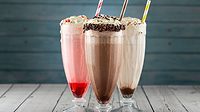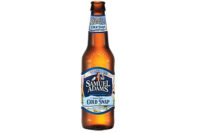![]()
Discussing Their Craft:
A brewers’ roundtable
|
The craft beer segment has become one of the bright
spots in a challenging beer market. While the overall beer industry saw
consumption declines last year, craft beers grew 3.4 percent. And according
to one industry source, specialty beers gained more than 14 percent market
share in the first half of 2004. After slowing a bit in the late
’90s, while it pared itself down from an overwhelming number of
companies and SKUs, it seems the craft beer industry is rising again, this
time as a more mature, more focused category.
Beverage Industry asked
several brewers, each representing a different region of the United States,
to tell us the reasons craft beer is growing, how the industry is different
today than it was during the frenzy of the mid-’90s, and how they
manage to attract and retain consumers in a world of big competitors.
Participating in our “roundtable” are George Hancock, chairman of Pyramid
Breweries, Seattle, Wash.; Kim Jordan, president of New Belgium Brewing Co., Fort Collins, Colo.; John Hall, founder of Goose
Island Brewing Co., Chicago; Steve Hindy, president of Brooklyn Brewery, New York City; and Fred Forsley, president of The
Shipyard Brewing Co., Portland, Maine.
Craft beer is enjoying nice sales increases in 2004. Why
do you think that is?
George Hancock: I think it
is important to point out that craft beer sales have increased every year
for the past couple of decades, but you are right to point out that the
rate of increase seems to be higher this year. There is no doubt in my mind
that improving economic conditions are a major factor.
Steve Hindy: The craft brewing industry has matured over the past 20
years. There now is a dominant craft brewery in just about every major
urban center in the country. Consumers are looking for high-quality,
locally produced products — products that enrich their lives. Craft
beers meet that need.
Many of us in the industry have enjoyed double-digit growth
for many years, and I expect that to continue for many more.
Fred Forsley: I think that
the consistency and quality of micro products is only improving. Because of
that, there's brand loyalty as well as bringing new customers into the
category which is allowing us growth from satisfied customers referring
products to satisfied customers.
In addition, the market is continuing to grow because the children of the baby-boomer generation are
turning 21 in unprecedented numbers. The craft beer industry is nearing 20
years old in America and an entire generation has grown up with a selection
of locally made beer. This maturation of our market is broadening our
consumer base.
Kim Jordan: I think this is the confluence of
a greater number of 25-45 year old consumers wanting to drink better, more
distinctive beer, and younger drinkers being accustomed to beer with more
interesting flavor profiles.
John Hall: American craft
beers are better than ever. The quality of the beers is very high, plus,
there is a large variety to satisfy the tastes of the majority of the
public.
Which of your products are most popular right now? Has
that changed over the years (have consumer preferences in your area been changing)?
Fred Forsley: Our flagship
brand, Shipyard Export Ale, is still our No. 1
product. It is close to 50 percent of our product mix. Additionally, our
seasonals continue to grow.
It seems that craft breweries are sliding gradually
toward more mainstream products and away from eclectic names and beer
styles without sacrificing integrity and quality. This evolution is
consistent with efforts to broaden the appeal of craft beer.
George Hancock: Pyramid
Hefeweizen is our biggest seller and is growing at a very nice lick. I
think the Hefeweizen style is coming into its own in many parts of the
country. People are overcoming their resistance to drinking a cloudy beer
and when they do, they realize it's a great beer that complements a wide
array of foods. We are seeing tremendous sales growth in states with warmer
climates.
John Hall: Goose Island Honker’s Ale, our flagship beer, has been
No. 1 since Day One. It is growing in our hometown of Chicago and out of
state. We think the growth is due to the fact that it has the character and
flavor of a craft beer with the drinkability and smoothness of other beers.
In other words, everyone who tries it really enjoys it!
Kim Jordan: Of course our biggest seller is Fat Tire. Having said that,
our Special Release line-up is doing really well as is our wheat beer,
Sunshine Wheat. Trippel, our Belgian Style Triple Ale has been a recent
sales phenomenon. There seems to be something of an emphasis on wheat
beers.
Steve Hindy: Our most popular brand (accounting for more than half our
sales) is Brooklyn Lager, and it has become even stronger now that we are
handled by a major New York distributor.
Brooklyn Brewery distributed its own products for the
first 16 years of our existence. We also distributed about 15 other
American craft beers, and virtually all the artisanal or craft brands from
Germany, Britain and Belgium. These products
competed directly with our beers, but we needed to build the whole category
of craft beer in New York City, and we felt self-distribution was the only
way to go. I don’t think we would have succeeded in establishing the
Brooklyn brand without self-distribution. New York’s distributors are
very big companies, and they are heavily influenced by the big
multinational breweries. We sold our distribution company to one of those
big distributors last year.
What are the biggest factors impacting your business
today?
George Hancock: We live in interesting times. The biggest factors are
consolidation in the marketplace, cost inflation, and the challenge to the
beer industry from a spirits industry that has been dormant for decades.
Fewer distributors in each market means that each of them handles more
brands and that makes it harder for small, independent brewers to get focus
for their beers. Consolidation of the retail chains means fewer, more
remote buyers with less feel for regional and local markets and fewer
overall craft beer SKUs.
Cost inflation has been quite dramatic for small
brewers — energy, medical benefits, workers compensation, insurance,
freight, — you name it and it is up, big time. It is tough to recoup
those costs in today's marketplace, although fortunately the national
brewers and importers are leading the way.
The awakened giants in the spirits industry are
advertising and going after the younger drinker with great success, and the
beer industry has helped them by introducing their brands via flavored malt
beverages. We have survived by weaning people in their mid- to late-20s
away from lightly flavored, mass produced lagers. The question is whether
we can wean those same people away from their favorite flavored spirits or
are we on the doorstep of another golden age of the cocktail.
John Hall: Our new products are impacting our business more than
anything else today. We have a new Reserve Line of beers… an
open-ended series of limited-edition extreme beers. We also are
brewing a new unfiltered wheat ale we call 312.
Fred Forsley: Securing time and mind-share from our distributors is our
biggest business challenge. It is equally challenging to get new
distributors to take our products in areas we want to grow. Rising costs of
raw materials and glass for bottles is also a challenge. We need to manage
those cost increases without creating major price increases for the
customer. Taxation is also a factor that impacts our business.
Kim Jordan: Access to market — the choice of distribution
strategies is limited for small brewers in America. This is a fundamental
and huge issue. As an industry segment, skillfully managing our growing
pains [is also an issue].
Also, neo-prohibitionist mindsets and groups around
the country. I am absolutely against drunk driving, and I worry that we are
criminalizing the person who goes out to eat and has one or two beers.
Steve Hindy: The biggest challenge we face today is learning to work
through the big distributor. He reaches 100 percent of the market, where we
were reaching only 25 percent or so. This was the top 25 percent of the
market, people who were interested in a product they learned of by
word-of-mouth, as opposed to traditional advertising. To get our story out
to all of New York, we started doing traditional advertising this year for
the first time. We are a sponsor of New York Yankees baseball on WCBS-AM.
The jury is still out on the effectiveness of that initiative.
How has your business changed since the craft beer peak
of the mid-90s?
Steve Hindy: Consolidation of the beer industry, and the beer distribution business is having a big impact on our
business. Small brewers have fewer and fewer choices of distribution when
they enter a new market. In many cases, the big distributors are not
interested in new brands, or small brands.
Another big challenge we face is expanding our brewing
business in New York City. There is tremendous pressure for residential
development in the city now, and it makes it difficult for us to find
affordable land to expand.
For years, we were promoting the whole category of
craft beer. We battled to create a niche for craft beer in New York City.
Today, we are battling to grow our brand, the Brooklyn brand.
Fred Forsley: Our business has matured in our approach to our planning. We
look further out. We also are continuously looking for innovative ways to
reach the consumer.
We are more reliant upon chain store sales and
pricing. Retailers and distributors are less likely to accommodate new
brands and distributors, and have consolidated to the point that they are
overburdened with suppliers.
George Hancock: We have had to get bigger, more professional, more
efficient, and more focused. The business is far more competitive. From
memory, I believe some 800 new brewers opened their doors between 1995 and
2000. One city of 200,000 where we have pretty good sales, opened six
breweries within a couple of years. That clearly makes it a tougher road
for all of us, but it really pushes you to improve, and the end result is
that the quality and choice of beers in the marketplace is tremendous.
Kim Jordan: [We have] more equipment, more
staff, and also perhaps more earnestness about the business side of running
the business — as in more systematic ways of making decisions. We try
to balance that with a continued desire to try new styles of beer.
John Hall: Craft beer did not peak for Goose Island
in the ’90s. The peak for us is now!
How is the craft beer industry as a whole different than
it was 10 years ago?
George Hancock: In some ways, it has not changed
at all. I was at the Oregon Brewers Festival pre-event dinner a couple of days
ago and I was glad to see a whole host of familiar faces from other brewers,
suppliers, distributors, retailers, and of course, the trade press. It remains
a congenial industry quite unlike any other and that is a huge part of the reward
for me and most other people I know.
In other ways, of course, it is very different and
more challenging. In particular, we face tough competition from the
local Pacific Northwest craft brewers who are aligned with Anheuser-Busch.
It makes it a lot easier in the marketplace to have the dominant brewer in
the nation by your side.
John Hall: The customer now is willing to embrace a wider array of
styles. This makes it easier for us to bring
out bigger, hoppier beers than we could 10 years ago.
Kim Jordan: I think that brewers get it that it takes a mix of
innovation, capitalization and good management. That might have been less
true 10 years ago.
Fred Forsley: The people who have remained in
the industry are the people who genuinely love beer and who genuinely love what
they do as a way of life. Ten years ago you could sell beer if it was good and
had a good story. Today it is not enough to simply make good beer. You need
a quality product, sales representation, significant marketing support, and
strong retailer relationships.
Steve Hindy: It is much more difficult to enter than it was 10
years ago. But it is healthy, and growing, and here to stay.
Your brands have to compete against some pretty big marketing budgets (Anheuser-Busch, Miller,
etc.). What kind of marketing do you do?
John Hall: We don’t think we compete against the beer companies
with huge marketing budgets. We are competing for a new type of customer,
and we market toward that customer through on- and off-premise events,
sampling opportunities, and sponsoring events and organizations that are
reaching for the same goals and representing the same principles as Goose
Island.
Kim Jordan: Not only can we not compete with those kinds of budgets, I'm
not sure that it's in our best interests to “compete” in that
sense. We have a great story to tell about New Belgium and that's what we
focus on. We try to make our marketing fresh and because it's done pretty
much all in-house, consistent with who we are.
George Hancock: Craft beer brands are not built
by marketing budgets. Like many craft brewers, we rely on sampling and word-of-mouth
to spread the good word about our beers. Our limited marketing dollars are mainly
aimed at point-of-purchase. We have invested in two small brewery/alehouses
in Northern California over the past couple of years and the sampling they provide
has definitely grown our business in those areas.
Fred Forsley: Most importantly, we focus on connecting directly with bars and retailers and develop relationships. Once
the product is out there, it sells. The biggest piece is getting it on
draft and on the shelf. Once customers can purchase our products, we can
easily compete against the big guys. We just need to be there — if
you don't show up to the dance you aren't going to get to dance with
anybody!
The traditional marketing mediums we use are: local
TV and radio, regional print, and nationally via internet.
Our most effective marketing is sampling through
on-premise promotion, non-profit contribution,
brew pubs and shipyard-theme pubs, and long-term retailer relationships.
Steve Hindy: Most of our marketing is guerrilla marketing: co-promotion with not-for-profits and arts
groups; tastings; dinners; festivals; special events at the brewery. We do
not try to compete directly with the big guys — at least not on their
terms, because we realize that is a battle we cannot win. But there are
many things we can do on the local level that they cannot do, many
opportunities that they do not appreciate, or understand. An example: the
Democratic National Convention [was] in Boston and the Republican is in New
York City. Newsday did
a comparison of the two cities, population, land area, sports teams, etc.
The New York beer [they chose] was Brooklyn Lager, and the Boston beer was
Sam Adams.
Are there other companies in the craft beer business that
you admire? Why?
Kim Jordan: Absolutely! This is a fun group of folks in a great industry
that has ancient roots. We have breweries that are technologically
sophisticated, breweries who are great story-tellers, breweries that do a
great job of crafting interesting beers. We also have breweries with really
interesting heritage, the August Schell and Matt Brewing Co. for instance.
Fred Forsley: I admire Sierra Nevada for their ability to grow
steadily and consistently. They've been able to distribute nationally while
maintaining price, quality and image.
George Hancock: There are lots of them. First is Anchor Brewing; Fritz is an
extraordinary person and I sit at his feet and listen any chance I can get.
Sierra Nevada for Ken Grossman's relentless quest for quality and for the
fact that he invested in capacity in the early/mid-’80s when the rest
of us where trying to figure out whether this was a real business or a
religious calling.
Deschutes — love
their beers. Widmer Bros. for their competitiveness; we really built the
wheat beer business together over the past couple of decades, but they have
ratcheted it up a notch since they aligned with A-B. Paul Shipman at Redhook is a pioneer and a great strategist. Jim
Koch at Boston Beer is the smartest marketer in the industry.
Of the newer breweries, New Belgium stumbled across a
great name for a beer, and they have executed extremely well. I could go on
and on, but maybe I can sum up by saying I really admire the really small
brewing businesses and their owners who are in the business because they
love their craft. They won't get rich doing what they are doing, but they
work their butts off year after year because of the sheer fun of turning
out great beers and comparing them to the other
guy's beer. I really admire them.
John Hall: I admire Sierra Nevada for sticking to their guns and making
great beer while never compromising quality. I also admire Sam Adams for introducing a huge volume of people to craft beer.
Steve Hindy: I admire everyone in the craft beer
industry who has had the guts and grit to endure. BI



